Brown birds with yellow beaks are some of the most eye-catching and beautiful creatures in nature. These birds come in a variety of sizes and shapes, from large to small, making them enjoyable to observe regardless of their size.
From the bright colors of its feathers to its distinct yellow beak, there is much to admire about these amazing creatures. In this article, we will delve into the fascinating world of brown birds with yellow beaks.
List of Brown Birds with Yellow Beaks
1. Common Myna
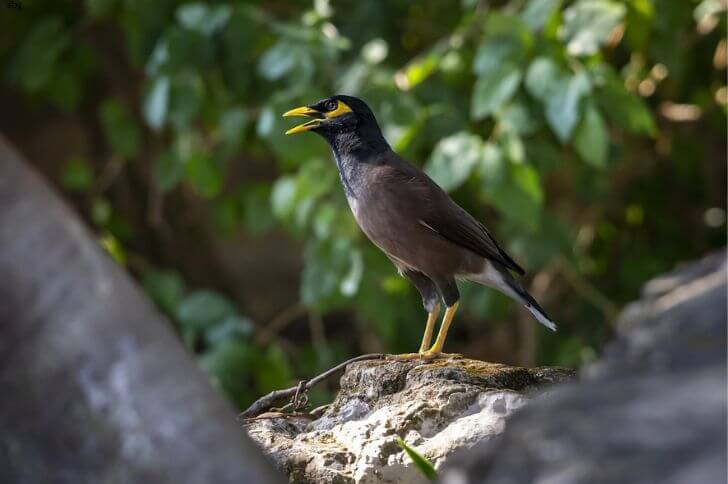
ID:
First introduced to Hawaii in the mid 1800s, the common myna is an adaptable, widespread bird of the starling family. Like house finches, their numbers have increased over time making them an invasive species.
On the Big Island, they are viewed as a nuisance since they displace most native birds like honeycreepers plus they cause massive destruction on fruits.
This species is easily identified by its black head and brown body with distinctive yellow patches around its eyes. Note the short sharp yellow beak and white rump. This bird with yellow beak also features bright yellow legs that make for a striking appearance.
How big is a common myna? About 9 inches; same size as a robin.
Habitat & more:
How long does this brown bird with yellow beak live? Common myna lifespan is 4-10 years. You can find this species in urban spaces as well as orchards and farmlands.
They are usually found in pairs or small groups which help distinguish them from other birds with similar coloring but different vocalizations. Their calls include squawks, croaks, and growls.
2. Karoo Thrush
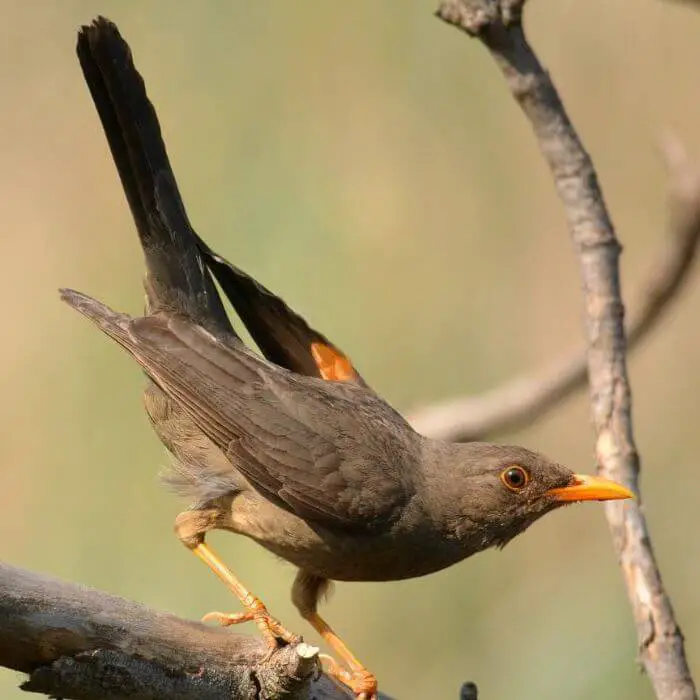
ID:
A common bird in South Africa, the karoo thrush is a medium-sized bird of the thrush family. Its related to the American robin.
Easily identified by its distinctive coloring, the karoo thrush has an olive-gray back, brown belly with a striking yellow bill. Notice the beautiful yellow eyering.
This brown bird averages 9 inches in length; same size as the common myna above. The Karoo thrush’s song is quite distinct, a melodic combination of “chk-chk’ notes.
Habitat & more:
This species can be found in open grasslands, thickets and semi arid savannas. To watch them, visit Limpopo, Free State and Northern Cape. Its diet consists primarily of insects such as beetles and grasshoppers as well as berries.
3. Yellow-billed Cuckoo

ID:
Yellow-billed cuckoos are migratory birds that often move back and forth between South America and North America.
Ranging from 10.2-11.8 inches, this bird is slightly larger than the myna above. You can tell it apart from other avian species within its range by looking for a medium size bird with brown back and white underparts.
Also be on the look for a bird with a long brown tail with large white spots. Bill is long and slightly curved. It’s mostly yellow.
Habitat & more:
Where can you find yellow-billed cuckoos? If you want to see their day to day activities, these cuckoos are found in South America during their non-breeding season. They then migrate and stay for a short time in Central America, finally moving to the eastern US to breed.
Speaking of breeding, there are two ways these brown birds with yellow beaks incubate their eggs. One, by building a nest on beech and oaks trees and incubating them for two weeks or leaving their nest in other birds nests and the host does the incubating.
4. Yellow-billed Babbler
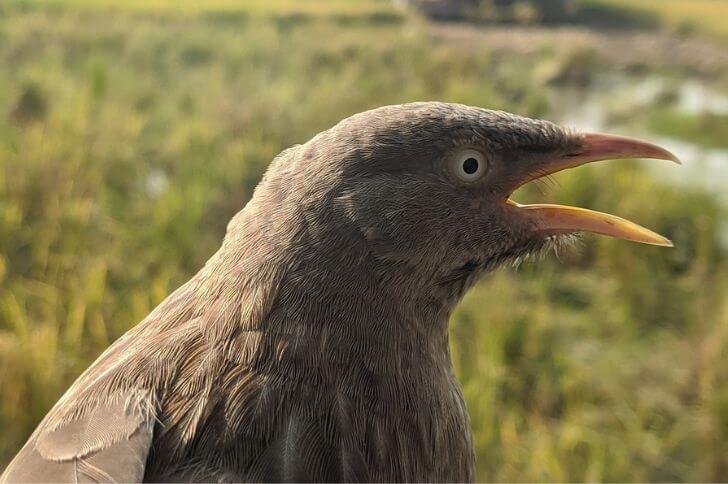
ID:
Termed as one of the noisiest birds in India, the yellow-billed babbler or argya affinis, is a species of passerine bird that also sports a yellow beak.
This small brown bird with yellow beak has an overall drab, streaked brown body with a yellow bill and vent. Note the pale crown and beautiful blue eyes.
Habitat & more:
These babblers feed mainly on insects but will also eat food scraps, fruit and nectar from flowers. They often forage in groups of up to 10 individuals but may also be seen alone or in pairs.
These brown birds with yellow beaks are great breeders; constructing cup shaped nests concealed in dense foliage. They lay blue eggs that hatch after two weeks. Also, bird watchers have observed them raising yellow-billed cuckoo babies as a result of brood parasitism.
Related Read: Check white and brown birds
5. Yellow-billed Oxpecker

source: ph0t0pe
ID:
Another bird of Africa that fits this category is the yellow-billed oxpecker. Native to Sudan, this medium sized bird prefers savannas and grasslands. This species of bird is distinctive due to its bright, two-colored beak and its long tail.
The yellow-billed oxpecker is about 7.9 inches in length and is overall brown with dark wings. They have bright red eyes that match the tip of their bill. The base of their bill is bright yellow.
Habitat & more:
Where can you find yellow-billed oxpeckers? Like their name suggests, around cattle. Their diet consists mainly of insects, larvae and ticks found on the backs of mammals such as cows or antelopes.
Their call is a series of ‘kriss-kriss’ sounds. They are gregarious birds.
6. White-crowned Sparrow

ID:
Identifying the white-crowned sparrow is relatively easy for birders of all levels. Found across all states all year round, these medium-sized songbirds can be identified by their grayish brown body, black and white striped head and a short bill that ranges from orange to yellow.
The brightly colored bill makes it easy to tell this small bird apart from other sparrows such as white-throated sparrows.
How large is a white-crowned sparrow? The adult is about 5.9-6.3 inches in length and span up to 9.4 inches. When up close you’ll notice its head appears flat.
Habitat & more:
White-crowned Sparrows have a unique song which consists of several different phrases repeated in quick succession with long pauses between each phrase. It is often described as “pink”; mostly made by males. .
7. Yellow-billed Kite

ID:
Are there birds of prey with yellow beaks? The yellow-billed kites fit the bill no pun intended. Found across Asia, Africa and Europe, this kite is about 21 inches long and spans about 30 inches.
Is the yellow-billed kite a hawk? No. though they belong in the same accipitridae family, these kites are in a different subspecies (Milvus).
The yellow-billed kite is a beautiful bird of prey with a distinctive bright yellow bill and brown streaked body. They have yellowish feet.
In flight, they are easily recognizable due to their slow flapping flight pattern combined with their very long tails which often appear the same size as their body length.
Additionally, their call consists of loud single notes or short bursts that carry far distances and sound like “keee-keee”. These vocalizations help distinguish them from other birds in the same area.
Habitat & more:
How long do these brown birds with yellow beaks live? Up to 24 years. They live in open areas where they can hunt easily. Their food consists of black rats, fish and smaller birds.
8. Ural Owl
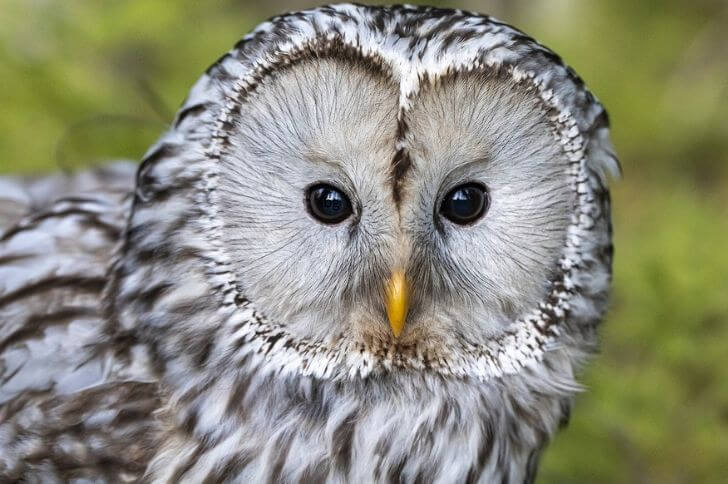
With an adult population of about 1.2 million, the ural owl is a member of the true owl family. These cute birds are pale gray-brown and white. The yellow bill is small in comparison to the size of their head.
Speaking of heads, like other true owls these birds have large round heads with large eyes. Their face is plain; no streaks. Also, their wedge-shaped tails are long like their cousin’s; the great gray owl.
The adult ural owl can grow to 2 feet and span up to 4 feet long. Like other birds of prey, their females are larger.
Habitat & more:
They are found in coniferous forests throughout Russia extending Scandinavia. They are nocturnal. During the day ural owls rest and are active most of the night. Their varied diet consists of frogs, rodents, and birds, particularly wood pigeons and grouses.
They are monogamous birds, often returning to the same nesting site each year.
9. Austral Thrush
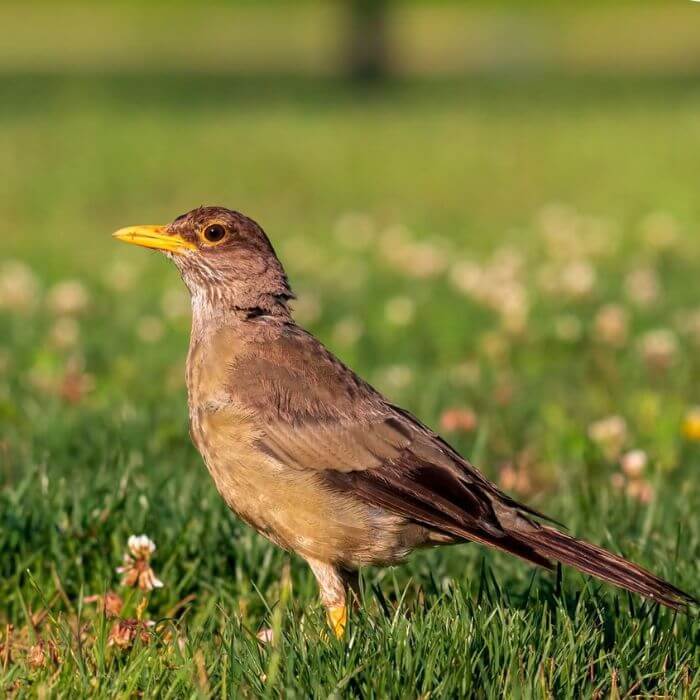
ID:
Closely related to the karoo thrush above, the austral thrush is a common bird native to Chile and Argentina.
It has a distinctively bright yellow bill and black crown that makes it easily recognizable among other birds living in the same region. Their body is gray-brown with a pale underbody.
Habitat & more:
Like most thrushes they frequent gardens and farms. Their diet consists of caterpillars, beetles, snails and spiders.
10. Black-breasted Parrotbill

Rare and endangered, the black-breasted parrotbill is a resident bird of East Asia. It is one of the smallest members of its family, measuring only 7.5 inches in length and weighing around 0.5 oz.
With its distinct brown body, white cheeks and black throat, the black-breasted parrotbill can be easily identified in its environment. Sexes are the same color. Notice their short bright yellow canonical bills.
Habitat & more:
They are typically found in areas with tall grasses and reeds.
11. Blue-throated Roller

ID:
The Blue-throated Roller is a striking species of bird found in parts of West Africa. It is non-migratory and terrestrial; often found on the ground foraging for food.
It easily stands out from other brown birds with yellow beaks. This species has an overall brown body with a blue throat and tail, and bluish-purple wings. The yellow bill is thick and wide. Most adults are about 9.5 inches long with the males being heavier than female rollers.
Habitat & more:
Where can you find these roller birds? They are native to sub-Saharan Africa; Angola, Cameroon, and Uganda.
They typically nest from February to April. They lay two to three eggs. Their diet consists mainly of insects such as termites and ants. They are gregarious birds, often coming together in small flocks in the afternoon to forage together.
12. Booted Eagle

ID:
Booted eagles are medium size brown birds that migrate between Africa, Asia and Europe depending on the season.
They are well-known for their impressive wingspan, 43.3-51.9 inches, and distinctive feathered legs. The size is about 15.7 inches. The coloring is mostly brownish gray with a pale rump. Their bill has a yellow base with a dark, almost black hooked tip.
Female booted eagles are twice as large as the males.
Habitat & more:
Booted eagles breed in southern Europe and in Africa from the north in Tunisia to South Africa. When breeding, like bald eagles, they build large nests out of twigs.
Females lay two green-tinted eggs between March and May. Baby eagles leave the nest after thirty eight days.
13. Wattled Lapwing

ID:
Conspicuous and unmistakable, wattled lapwings are medium size birds that are common in Sub Saharan Africa.
They get their name from wattles or fleshy patches that hang from the sides of the bill. Also the yellow colored wattles match the yellow bill.
In addition to these striking facial features, wattled lapwings are overall brown with a black crown and white forehead. Notice their long yellow legs.
Habitat & more:
They are known for their loud “peep-peep” call which is often heard across savannas, wetlands and grasslands in the evening or early morning hours. Additionally they nest on flat ground in open areas such as pastures or grasslands where they can easily spot predators approaching their nest site.
Conclusion:
In conclusion,brown birds with yellow beaks are a common sight among many areas of the world. Whether they are small sparrows, powerful eagles, or curious thrushes, these birds offer us a glimpse into the beauty of nature.
They bring life to the environment and have been known to bring joy to those who observe them. Though their appearance may seem simple, each bird is unique in its own way and offers something special for us to appreciate.
Sources:
https://en.wikipedia.org/wiki/Common_myna
https://ebird.org/species/watlap1
https://en.wikipedia.org/wiki/Booted_eagle
Hi fellow bird watcher. Welcome to our small corner of the world. At the spanishbirdguides.com our mission is to share with other bird watchers the things we love about birds, where to go bird watching within the United States, and more. I’d also love to hear from you. Feel free to contact me about your bird watching escapades, share videos, photos and more.


